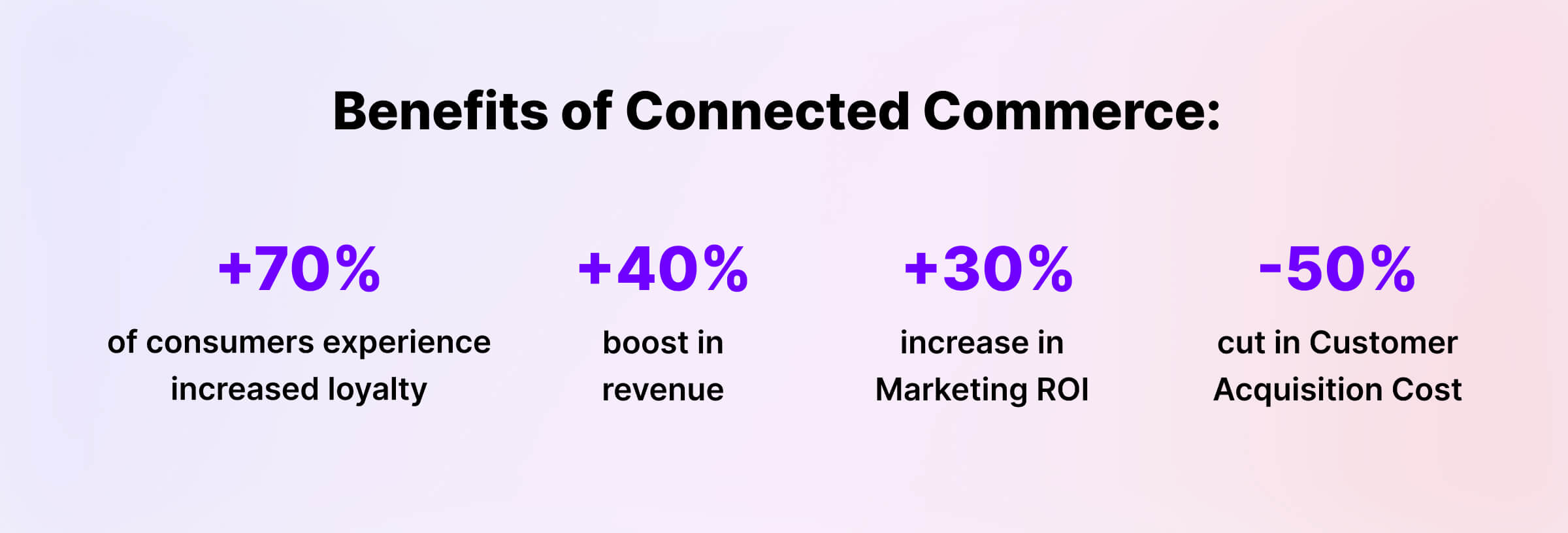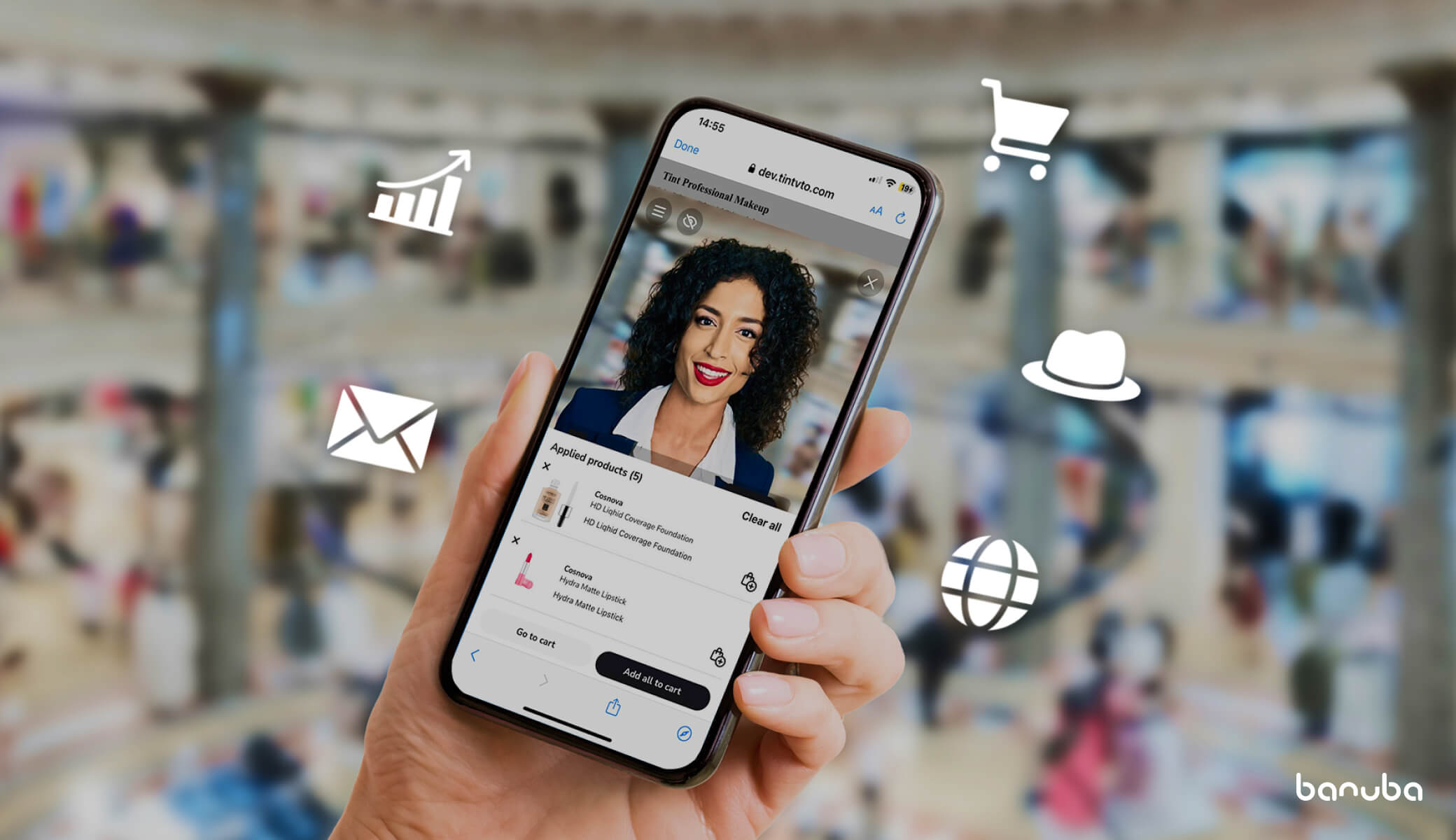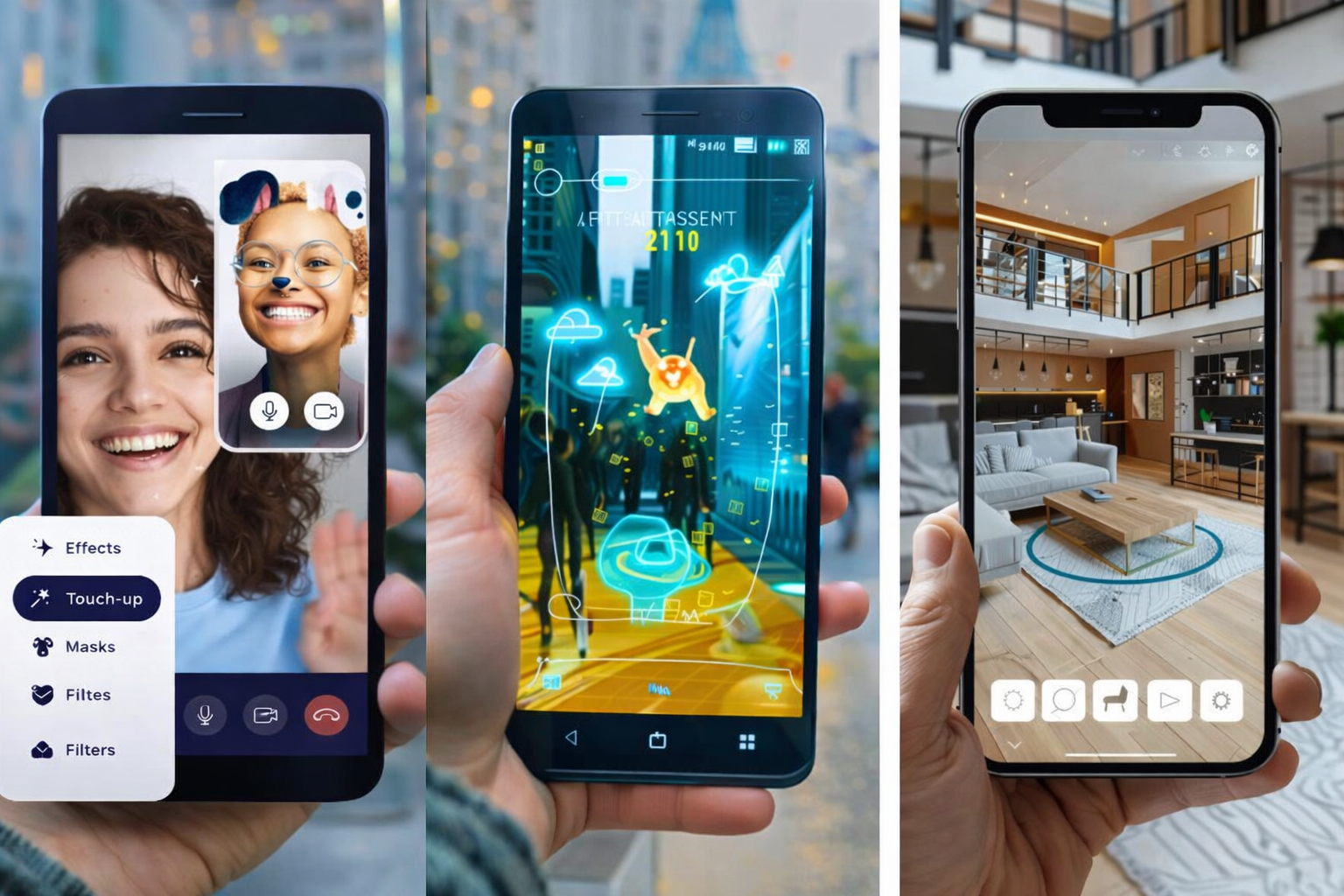[navigation]
TL;DR
- Connected Commerce integrates digital and physical shopping, providing a seamless, personalized experience across multiple online, mobile, and in-store touchpoints.
- Retail 5.0 emphasizes empathy, sustainability, and AI, blending high-tech solutions with human-centric experiences.
- B2B eCommerce benefits from automation and real-time data integration, improving operational efficiency.
- Virtual Try-On and AR improve customer confidence, boost engagement, and reduce returns. Solutions like TINT from Banuba can help businesses shift to Retail 5.0.
- Future Trends: AI-driven hyper-personalization, virtual try-on and VR, 4D printing, Device-as-a-Customer (DaaC), and sustainability-driven retail strategies.
What is Connected Commerce?
In simple terms, connected commerce integrates every touchpoint of a shopping journey into one cohesive experience, where a customer is the center of all activities. Whether your customers are in-store, browsing on social media, or shopping on your mobile app, they should feel like they’re interacting with the same brand — because they are!

Here’s the magic formula of connected eCommerce:
- Omnichannel: All channels work together — store, online, social, mobile — because who shops just one way anymore? According to Harvard Business Review statistics, 73% of buyers use multiple channels, while 90% expect consistent interaction with brands across all of their channels and devices. Businesses that implement omnichannel approach retain 89% of their clients.
- Seamless Data Flow: You know what they’ve browsed, tried, or purchased, and they feel understood (it’s not creepy if you do it right).
- Personalization: Tailored recommendations based on past behavior and preferences. Yes, it feels like mind-reading. In fact, 66% of consumers expect brands to “read their minds”, while a tailored experience increases the likelihood of purchase for 80% of shoppers.

Retail 5.0: The Next Big Thing? No, It’s Already Here!
If Retail 4.0 was about digitization and automation, Retail 5.0 is the upgrade we all needed but didn’t know we wanted. Why? Because it’s all about blending high-tech with high-touch. Think of it as shopping with heart—powered by AI- but focusing on empathy, sustainability, and human-centered design.
Here’s what Retail 5.0 brings to the table:
- Hyper-Personalization: AI-powered recommendations that know you better than your best friend.
- Sustainability: From reducing waste to transparent supply chains—because your customers care.
- Augmented Reality (AR) and Virtual Reality (VR): Making online shopping feel as real as physically being in the store (minus the bad lighting in dressing rooms).

Real-time data is king in Retail 5.0. It’s not enough to just know what customers bought last week. You need to understand what they’re thinking right now and offer them relevant products when and where they need them. Kinda like a retail sixth sense.
How B2B eCommerce Integration Powers Connected Commerce
Don’t think that connected commerce is just for retail giants and fashion brands. B2B businesses are catching on, and they’re loving it. B2B eCommerce integration isn’t just about selling; it’s about streamlining operations from top to bottom. This means procurement systems talk to your eCommerce platform in real-time, reducing the need for manual processes like invoicing and inventory management.
Here’s why B2B eCommerce integration is crucial:
- Automation: Automated processes reduce errors and allow your team to focus on what matters—building relationships.
- Real-time Data: Helps companies anticipate demand, manage supply chains, and avoid stockouts.
- Tailored Experiences: Even in B2B, personalization matters. Integrated systems can create custom experiences for different business clients.
The Benefits of Connected eCommerce: Why It’s a Game Changer

Connected eCommerce isn’t just about fancy technology—it’s about delivering real, measurable value to businesses and customers alike. Here’s why adopting this approach is essential:
Seamless Customer Experience
Impersonal experiences make 71% of buyers frustrated. With connected retail, customers can move effortlessly between online, mobile, and in-store shopping. This creates a consistent and personalized experience no matter where they interact with your brand. The result? Increased loyalty and satisfaction. According to Salesforce, the brand’s knowledge of its buyer’s needs increases loyalty for 70% of consumers.
Higher Conversion Rates
Customers who experience personalization (think custom recommendations based on past behavior) are more likely to complete their purchases. Besides, it can increase marketing ROI by 30% and reduce client acquisition costs by 50%. It’s up to your business niche how to implement this personalization. For example, virtual try-on tools in the beauty and accessories domains can boost conversion rates by 200%, giving customers more confidence in their purchases. By eliminating their doubts, VTOs increase the average order value by 30%. In our previous article, you can read more about how virtual try-on can improve the add-to-cart conversion rate.
Reduced Returns
The philosophy of connected retail ensures the experience and products are customer-centered, i.e., hyper-personalized. According to McKinsey, companies with proper personalization strategies can receive 40% more in revenue. Virtual try-ons and detailed product visualizations help customers make more informed decisions. This means fewer purchases that don’t meet expectations and fewer returns. For businesses, this translates into significant savings on shipping and restocking costs.
Enhanced Data Insights
Connected commerce creates a goldmine of data insights. With every interaction tracked and analyzed, businesses can better understand customer preferences, predict trends, and optimize inventory management.
Improved Operational Efficiency
Businesses can operate more efficiently and at scale by implementing B2B eCommerce integration and automating processes like invoicing, shipping, and stock management. This is particularly helpful for B2B companies where complex supply chains and large order volumes benefit from real-time data.
Reach a Wider Audience
With omnichannel strategies and the ability to shop anytime, anywhere, connected commerce allows businesses to engage more customers than ever. This includes leveraging social commerce, mobile apps, and even virtual stores.

Looking Ahead: The Future of Connected Commerce
So, what does the future of connected retail hold? Well, buckle up because the sky’s the limit.
- More AR and VR: Expect virtual try-ons to get even more realistic. The market is expected to grow at a CAGR of 26.4% until 2030. We’re talking about full-body scanning and virtual environments that allow customers to try on skincare, plastic surgeries, or design their living rooms with precision.
- AI-Driven Personalization: Retailers will continue refining their ability to offer hyper-personalized experiences, predicting what customers need before they know it themselves. With ChatGPT in everyone’s pocket and the 28.46% CAGR of the AI industry, data-driven personalization could really learn how to read minds.
- Device as a Customer (DaaC): Everyday devices make purchasing decisions on behalf of their owners. Imagine your fridge reordering groceries or your printer automatically replenishing ink. This shift creates an entirely new market dynamic called Business-to-Thing (B2T) management, where devices, driven by algorithms, evaluate products based on user preferences like cost, quality, or urgency. The challenge? Marketing to emotionless devices that make decisions based solely on predefined business rules, not human persuasion.
- Sustainability as Standard: As consumers become more environmentally conscious, retailers will integrate sustainability into their core business models, not just as an add-on.
- Make Your Own Product: As 3D printing becomes more accessible, consumers can now print their products, from everyday items to complex biotech materials. This shift empowers consumers to create customized, on-demand products, potentially outpacing traditional retailers by eliminating the need for shipping or in-store purchases.
Steps to Make eCommerce Connect: From Fragmented to Unified
Moving towards a connected business experience isn’t just a nice-to-have anymore—it’s essential for thriving in today’s market. So, how do you take your e-commerce strategy from fragmented to fully connected retail?
Build Personal Relationships
Customers crave personalization, so give them tailored offers and smart recommendations. Encourage them to share data by offering something valuable in return—exclusive offers or perfectly timed incentives.
Offer Connected eCommerce Platforms
Let your customers hop between touchpoints effortlessly. Whether they start browsing on their phone and finish on a laptop or move from app to store, make the experience smooth. Real-time data sharing is key here, and the aim is for one-touch simplicity.
Create Valuable Experiences
Offer more than just products; share inspiring, educational, and engaging content. Help them make informed purchase decisions with enhanced search features, detailed product info, and a seamless browsing experience. For example, virtual try-on and try-before-you-buy can be integrated into any touchpoint and even in-store via smart mirrors.
Provide Flexibility
Be the brand that’s there when they need you. Think same-day delivery, precise drop-off windows, and competitive pricing on essential items. Flexibility will meet their immediate and unplanned needs.
Help Customers Do Good
Today’s shoppers care about the planet. Align your brand with their values by offering sustainable products and services, all while ensuring the price point remains fair. A win for them and the earth! Replace promo packages with virtual testers sent via email and reduce your carbon footprint.
Virtual Try-On and Try-Before-You-Buy in Connected eCommerce
Remember when shopping for glasses, makeup, or even furniture online felt like a gamble? No more! Virtual try-on technology bridges the gap between “I think this will look good” and “Wow, that looks amazing!” by letting you see the product on yourself in real time.
Here’s how it works:
- AR-Powered Technology: Augmented reality lets you use your phone or any other device with a camera to see how a product—sunglasses, jewelry, or even lipstick—looks in your environment.
- Confidence Booster: Customers are likelier to purchase (and keep) products they’ve tried virtually because it removes the guesswork. According to ThreeKit, VTO can increase conversion rates by 40% and engagement rates by 200%.
- Reduced Returns: Less “Oh, this doesn’t fit” and more “This is perfect!” Virtual try-on reduces return rates dramatically, helping retailers save on logistics costs.
How TINT Can Help Your eCommerce Connect
At Banuba, we believe that the future of retail is already here, and we can help brands embrace it. Our TINT virtual try-on platform is designed for seamless integration and help shift to connected retail, offering cutting-edge AR and AI technologies that enhance customer engagement and boost sales.
With TINT, you can adapt your business to connected eCommerce in the following domains:
- beauty industry: makeup, skincare, nail polish, hair coloring;
- eyewear: sunglasses, colored contacts, eyewear, and frames;
- accessories: headwear, jewelry, rings, etc.
How can TINT help turn your business into connected eCommerce?
- Seamless Integration: Our SDK fits effortlessly into your existing platform—no need to overhaul your systems. Our solution is available on the Web, iOS, Android, smart mirrors, and desktops, making your brand truly omnichannel.
- Boost Engagement: With virtual try-ons, smart product recommendations, seasonal analysis, and the personal AI advisor, your customers will spend more time on your site and be more likely to purchase.
- Reduce Returns: Fewer returns mean lower costs and happier customers.
- Coherence with consumers’ values: With sustainability in trend, you can eliminate your expenses on recycling testers or returned items or cut logistics costs.
- Fast product digitalization: You can digitilize the products yourself, or get them uploaded into your library in up to 48 hours. Imagine letting your potential buyers try on the new collection before it hits the shelves.

Conclusion: The Time is Now
Connected commerce and Retail 5.0 are transforming the shopping experience as we know it. From virtual try-ons to B2B eCommerce integration, the future is about creating seamless, meaningful interactions that keep customers returning for more.
So, are you ready to take the plunge? Embrace the future with Banuba’s virtual try-on technology and elevate your business in ways you never thought possible. Let’s make shopping magical again.










